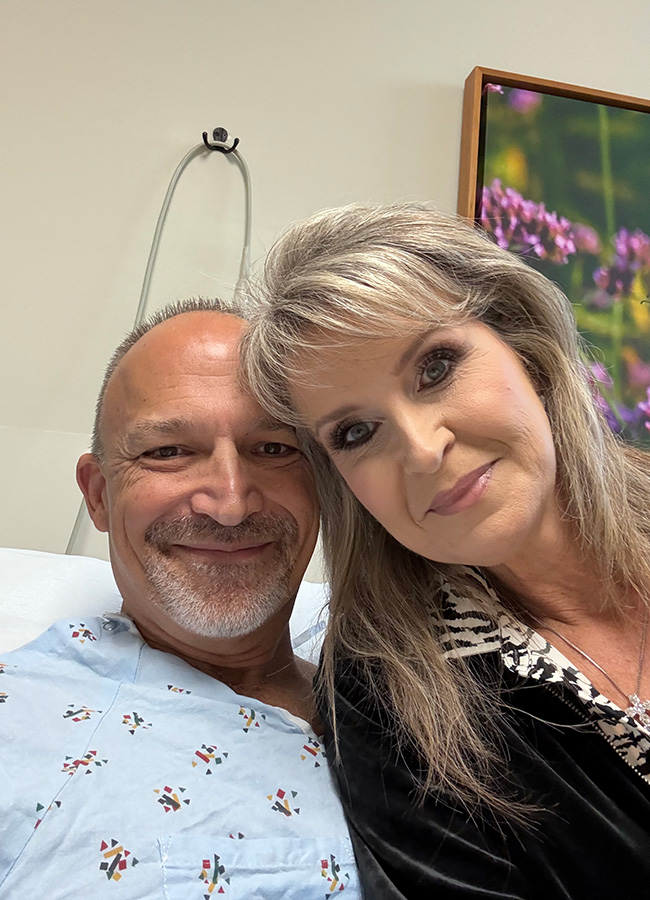 Jason Junkins, M.D., and his wife, AngelaFor local urgent care physician Jason Junkins, M.D., prostate cancer was not on his radar. The UAB St. Vincent’s patient faithfully tracked his health and was shocked when a routine colonoscopy — prompted by an unrelated iron deficiency — uncovered the surprise eventual diagnosis.
Jason Junkins, M.D., and his wife, AngelaFor local urgent care physician Jason Junkins, M.D., prostate cancer was not on his radar. The UAB St. Vincent’s patient faithfully tracked his health and was shocked when a routine colonoscopy — prompted by an unrelated iron deficiency — uncovered the surprise eventual diagnosis.
Junkins, who specializes in internal medicine, diligently monitored his health, including annual prostate-specific antigen checks, which consistently came back normal.
“I’ve checked my PSAs and all my labs every year; they have been totally normal,” Junkins said. “There has never been any rise in them. They’ve been stable as a rock.”
The unexpected chain of events began when a doctor who had ordered labs for Junkins also checked his ferritin, a test for iron deficiency. While iron-deficient, Junkins was not anemic and experienced no symptoms. This iron deficiency prompted a standard workup, which included a colonoscopy — a procedure he had planned for the following year.
“Because of my iron deficiency, we had to see where it was coming from,” Junkins said.
During the colonoscopy, an unusual observation was made. After the colonoscopy, his physician mentioned he noticed Junkins’ prostate was enlarged and asked if he had had it checked recently.
This led Junkins to consult Scott Tully, M.D., a urologist at UAB St. Vincent’s. Despite Junkins’ normal PSA levels and no family history of prostate cancer, an MRI was recommended due to the enlarged prostate. The MRI revealed a 1.4-centimeter lesion, leading to a biopsy that confirmed a Gleason 7 prostate cancer, indicating a more aggressive form that necessitated immediate treatment rather than active surveillance.
“PSA screening is an initial test that can be done, but it is an imperfect screening test in the sense that there are a lot of false positives,” Tully said.
For men, prostate cancer remains a primary concern, with screenings typically recommended starting at age 45. PSA screenings should be combined with a digital rectal exam.
“In some cases, the tumor can be non-PSA-producing, which means a PSA screening would not show a gradual elevation,” Tully said. “That is the reason we recommend the digital rectal exam in combination with PSA screening and check the prostate. In some cases, the PSA is normal but there is abnormality on the physical exam, and often those can be more aggressive cancers.”
After weighing his treatment options with Tully, Junkins opted for surgery, a prostatectomy, performed at UAB St. Vincent’s. The entire process, from discovery to surgery, transpired remarkably quickly.
“I wanted to get it out, because that’s really the best chance of beating the cancer,” Junkins said. “In about a two-month period, we went from not knowing I had anything to having the prostatectomy.”
Post-surgery pathology showed clear margins and no lymph node involvement, offering a promising prognosis. Junkins’ experience underscores the critical importance of a thorough physical exam, particularly the digital rectal exam, in conjunction with PSA testing.
“Had my GI doctor not found that on my colonoscopy, I would still be thinking everything was fine based on my normal PSA levels,” Junkins said.
Junkins and Tully encourage men to be proactive about their health and not rely solely on PSA tests.
“The rectal exam matters. It is something that needs to be done and patients need to ask for themselves,” Junkins said. “If an educated physician with all the health care resources in the world can have prostate cancer sneak up on him, it can sure enough sneak up on anybody else.”
Tully echoed this sentiment, advising men to be vigilant. “I think men fear getting checked and finding problems like this out. It is better to screen for any cancer to detect it earlier when it is in a more curable state than waiting till it’s more advanced,” Junkins said.
Junkins’ journey has instilled a profound sense of gratitude, and he hopes his story will encourage other men to prioritize comprehensive health screenings, establish a relationship with a primary care provider and engage actively in their health care decisions.